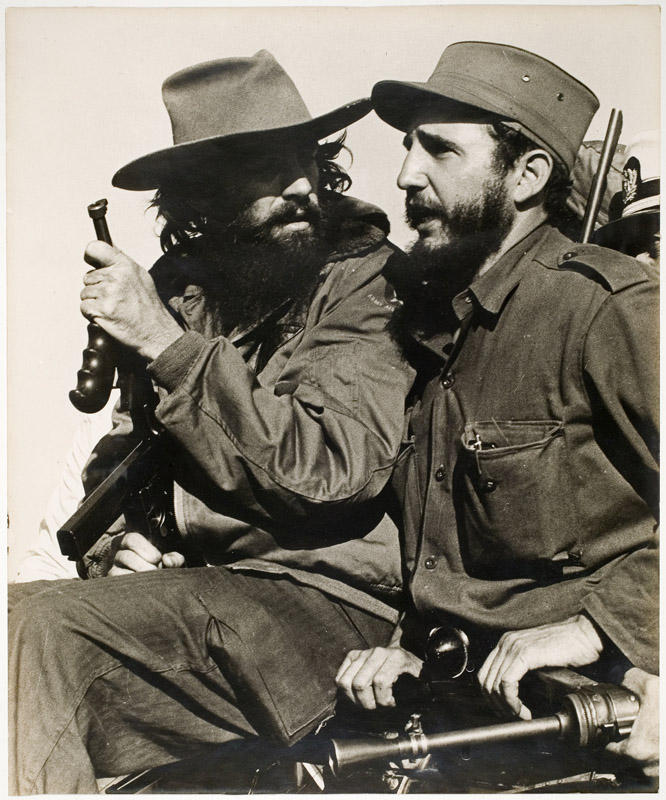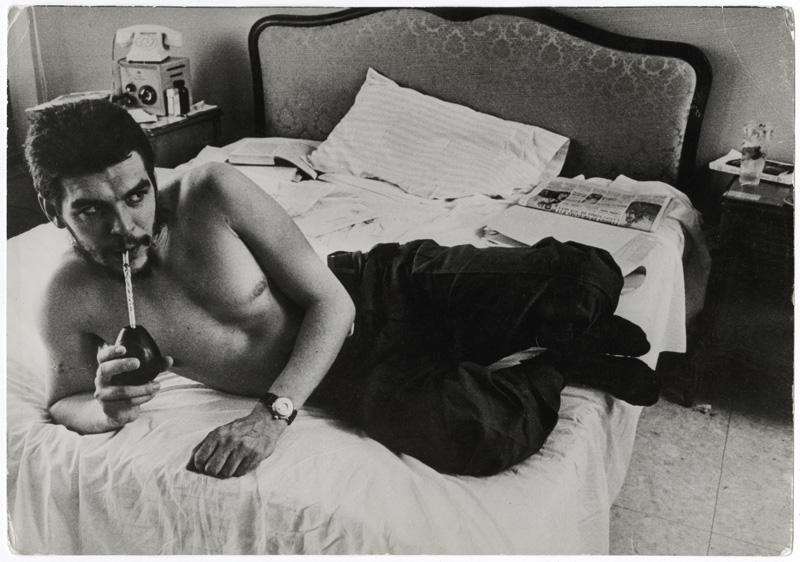 JTF (just the facts): A group show containing a total of 160 black and white photographs, generally framed in black and matted, and hung against taupe and red walls throughout the entire lower level of the museum. The exhibit also includes vintage newsreels projected on a screen, 2 glass cases displaying various magazine spreads, and a video. (Luis Korda, Fidel Castro and Comandante Camilo Cienfuegos entering Havana, January 8, 1959, at right, top, via ICP.)
JTF (just the facts): A group show containing a total of 160 black and white photographs, generally framed in black and matted, and hung against taupe and red walls throughout the entire lower level of the museum. The exhibit also includes vintage newsreels projected on a screen, 2 glass cases displaying various magazine spreads, and a video. (Luis Korda, Fidel Castro and Comandante Camilo Cienfuegos entering Havana, January 8, 1959, at right, top, via ICP.)
The show is divided into eight chronological sections, each with a title and start and end dates, together spanning the period between the mid 1940s and the late 1960s. The photographers included in each section are listed below, with the number of prints on view in parentheses:
Pre-Revolutionary Havana: Constantine Arias: 1945-1957
Constantine Arias (18)
The Fall of Batista: 1958-1959
Tirso Martinez (1)
Guillermo Morales (1)
Osvaldo Salas (1)
Unknown (4)
The Years of Struggle and Victory: 1958-1959
Ernesto Fernandez (1)
Burt Glinn (6)
Antonio Nunez Jimenez (1)
Luis Korda (1)
Tirso Martinez (2)
Roberto Salas (1)
Flip Schulke (2)
Andrew St. George (4)
Unknown (4)
Diplomacy and the Cold War: 1959-1964
Sergio Canales (5)
Henri Cartier-Bresson (1)
Mario Collado (1)
Bob Henriques (1)
Alberto Korda (5)
Osvaldo Salas (2)
Andrew St. George (3)
Heroic Portraits
Rene Burri (9)
Elliott Erwitt (1)
Bob Henriques (1)
Alberto Korda (9)
Lee Lockwood (2)
Tirso Martinez (1)
Liborio Noval (1)
Aldo Diaz Rodriguez (1)
Osvaldo Salas (3)
Andrew St. George (4)
Unknown (5)
Picturing the Cuban People: 1959-1963
Henri Cartier-Bresson (1)
Raul Corrales (5)
Burt Glinn (1)
Alberto Korda (3)
Lee Lockwood (1)
Flip Schulke (4)
Andrew St. George (1)
Che Guevara: The Death and Rebirth of an Icon: 1967
Brian Moser (10)
Freddy Alborta Trigo (8)
Cuban Counterculture and Exile: 1965-1968
Jose Figeroa (14)
The exhibit was curated by Brian Wallis and Mark Sanders, in association with the International Art Heritage Foundation. Since photography is not allowed in the ICP galleries, there are unfortunately no installation shots for this show. (The images at right come via the ICP website.)
 Comments/Context: OK. I’ll admit it. As I walked down the stairs to the Cuba in Revolution exhibit in the basement of the ICP, I was thinking to myself that this was going to be yet another dry historical survey, interesting at a high level from a factual perspective, but likely a show I would decide to pass on reviewing altogether. So much for preconceived notions. While the show downstairs does travel a chronological path of Cuban history, what is exciting and unexpected is how the story is told through photography: how the local and international photojournalists chose to chronicle the revolution (which narratives to follow and how to portray them), how the cult of personality was created around the leaders, and how scenes were stylistically created that embodied certain heroic attributes and emotions. What’s interesting here is not so much the gathering of the well-known facts, but the entire construction of national history going on along the way via photography. (Raul Corrales, La Cabelleria, 1980, at right, middle, via ICP.)
Comments/Context: OK. I’ll admit it. As I walked down the stairs to the Cuba in Revolution exhibit in the basement of the ICP, I was thinking to myself that this was going to be yet another dry historical survey, interesting at a high level from a factual perspective, but likely a show I would decide to pass on reviewing altogether. So much for preconceived notions. While the show downstairs does travel a chronological path of Cuban history, what is exciting and unexpected is how the story is told through photography: how the local and international photojournalists chose to chronicle the revolution (which narratives to follow and how to portray them), how the cult of personality was created around the leaders, and how scenes were stylistically created that embodied certain heroic attributes and emotions. What’s interesting here is not so much the gathering of the well-known facts, but the entire construction of national history going on along the way via photography. (Raul Corrales, La Cabelleria, 1980, at right, middle, via ICP.) Collector’s POV: While none of the works on view in this museum exhibition was for sale, many of the images by Magnum photographers can be found from time to time in the secondary markets or are likely available as modern prints directly from Magnum. Of the native Cuban photographers, Alberto Korda has the most robust history at auction, with a handful of prints selling between $1000 and $17000 in recent years, his famous Guerrillero Heroico at the top end of that range. (Andrew St. George, Che Guevara relaxing in his room at La Cabana fortress and drinking mate, 1959, at right, via ICP.)
Collector’s POV: While none of the works on view in this museum exhibition was for sale, many of the images by Magnum photographers can be found from time to time in the secondary markets or are likely available as modern prints directly from Magnum. Of the native Cuban photographers, Alberto Korda has the most robust history at auction, with a handful of prints selling between $1000 and $17000 in recent years, his famous Guerrillero Heroico at the top end of that range. (Andrew St. George, Che Guevara relaxing in his room at La Cabana fortress and drinking mate, 1959, at right, via ICP.)Transit Hub:




